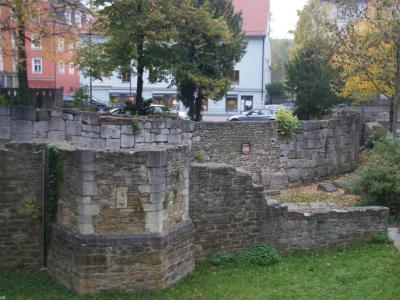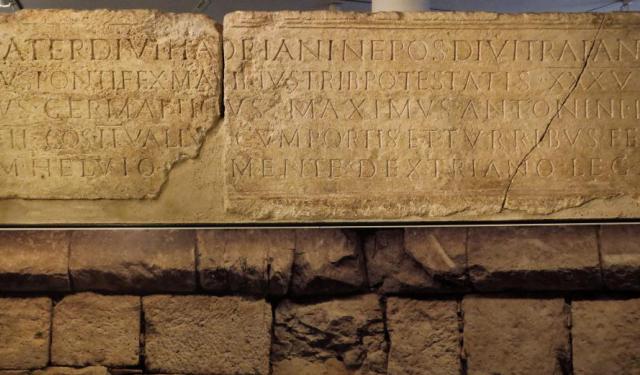Southeast Corner of the Fortress Wall, Regensburg
The southeast corner of the former Roman fortress holds historical significance and is now a part of the "document Legionslagermauer." Through archaeological excavations carried out in 1955 and 1961, a large conservation zone was established, allowing for a remarkable glimpse into the structure of the Roman fort's wall.
During that time, Horst Bergschneider, a notable resident of Regensburg, played a crucial role in fundraising and raising awareness for the preservation of the Roman wall at this particular location. His dedication and efforts were commendable and had a significant impact.
Exploring this area, visitors can witness the impressive curvature of the southeast corner of the legionary fortress, which seamlessly connects to the northward and westward extensions of the legionary wall. Notably, the remains of the podium with its characteristic slant are still visible. At the top of the curve, there is a rubble wall, likely added during the Middle Ages to replace a protruding corner tower.
Towards the north, the ruins of a medieval fortified tower merge with the Roman masonry, demonstrating the transition from Roman to medieval fortification at this site. This combination emphasizes the remnants of the lower bailey, including a tower dating back to 1389.
Interestingly, both of these walls continued to serve their defensive purpose until the early 19th century. Only after Regensburg was bombarded and attacked by Napoleonic troops in 1809 did their defensive role diminish. As a result, large portions of the walls were removed and filled in, contributing to the protection of the lower section of the Roman wall.
During that time, Horst Bergschneider, a notable resident of Regensburg, played a crucial role in fundraising and raising awareness for the preservation of the Roman wall at this particular location. His dedication and efforts were commendable and had a significant impact.
Exploring this area, visitors can witness the impressive curvature of the southeast corner of the legionary fortress, which seamlessly connects to the northward and westward extensions of the legionary wall. Notably, the remains of the podium with its characteristic slant are still visible. At the top of the curve, there is a rubble wall, likely added during the Middle Ages to replace a protruding corner tower.
Towards the north, the ruins of a medieval fortified tower merge with the Roman masonry, demonstrating the transition from Roman to medieval fortification at this site. This combination emphasizes the remnants of the lower bailey, including a tower dating back to 1389.
Interestingly, both of these walls continued to serve their defensive purpose until the early 19th century. Only after Regensburg was bombarded and attacked by Napoleonic troops in 1809 did their defensive role diminish. As a result, large portions of the walls were removed and filled in, contributing to the protection of the lower section of the Roman wall.
Want to visit this sight? Check out these Self-Guided Walking Tours in Regensburg. Alternatively, you can download the mobile app "GPSmyCity: Walks in 1K+ Cities" from Apple App Store or Google Play Store. The app turns your mobile device to a personal tour guide and it works offline, so no data plan is needed when traveling abroad.
Southeast Corner of the Fortress Wall on Map
Sight Name: Southeast Corner of the Fortress Wall
Sight Location: Regensburg, Germany (See walking tours in Regensburg)
Sight Type: Attraction/Landmark
Guide(s) Containing This Sight:
Sight Location: Regensburg, Germany (See walking tours in Regensburg)
Sight Type: Attraction/Landmark
Guide(s) Containing This Sight:
Walking Tours in Regensburg, Germany
Create Your Own Walk in Regensburg
Creating your own self-guided walk in Regensburg is easy and fun. Choose the city attractions that you want to see and a walk route map will be created just for you. You can even set your hotel as the start point of the walk.
Roman Ruins Walking Tour
Meandering through the Old Town of Regensburg, it’s easy to forget that some 1800 years ago most of this area was occupied by a Roman fortress. Although the first settlement here dates from as early as the Stone Age, it is the Romans who put it firmly on the map.
Around 90 AD, they first built an expeditionary and then a permanent military camp called Castra Regina ("Fortress by the... view more
Tour Duration: 1 Hour(s)
Travel Distance: 1.4 Km or 0.9 Miles
Around 90 AD, they first built an expeditionary and then a permanent military camp called Castra Regina ("Fortress by the... view more
Tour Duration: 1 Hour(s)
Travel Distance: 1.4 Km or 0.9 Miles
Regensburg Introduction Walking Tour
During a battle in 1809, Napoleon remarked that Regensburg was “worth a crown.”
The name “Regensburg” reflects its roots: it comes from the River Regen, which joins the Danube here, and the Old High German word burg, meaning fortress—so Regensburg means “the fortress by the Regen.”
Long before the Romans, Celtic tribes had already settled on the high ground, taking advantage of... view more
Tour Duration: 2 Hour(s)
Travel Distance: 4.1 Km or 2.5 Miles
The name “Regensburg” reflects its roots: it comes from the River Regen, which joins the Danube here, and the Old High German word burg, meaning fortress—so Regensburg means “the fortress by the Regen.”
Long before the Romans, Celtic tribes had already settled on the high ground, taking advantage of... view more
Tour Duration: 2 Hour(s)
Travel Distance: 4.1 Km or 2.5 Miles





